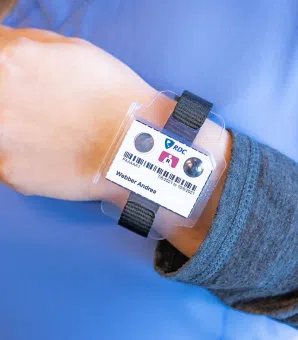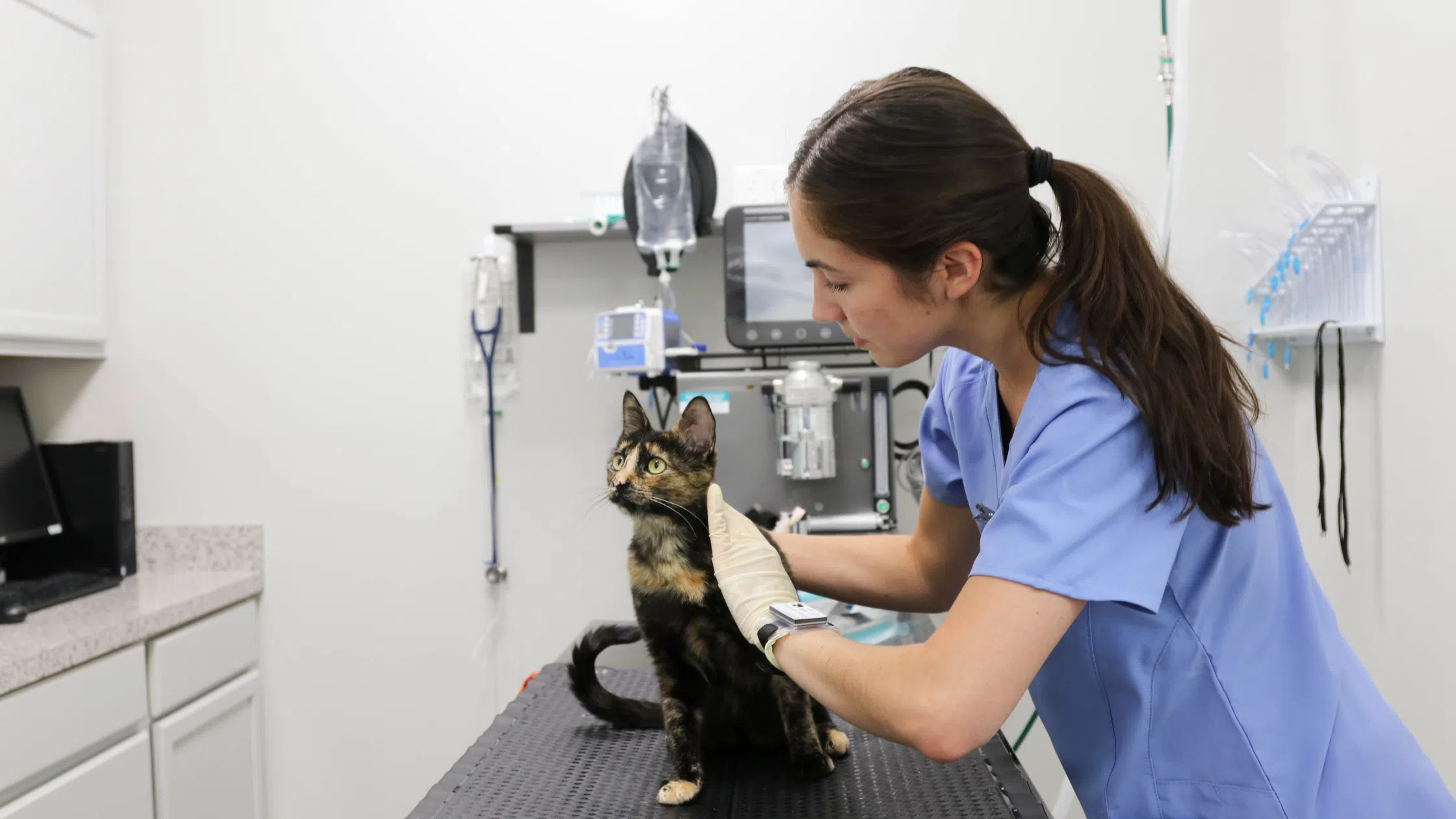
Dosimeter badge services for medical, dental, and veterinary businesses
Learn how Radiation Detection Company’s easy-to-use dosimetry solutions can boost the efficiency of your practice.
At RDC, we are in the business of providing dosimetry solutions to organizations throughout the United States. Radiation badges play a major role in the solutions we offer. So whether you’re new to the radiation monitoring space, or you’re a seasoned veteran, this article can serve as your one-stop shop for all things radiation badges.
We hope you find this article informative, and as always, we look forward to hearing your feedback!
A radiation badge - also commonly called a personal dosimeter - is a device that measures the absorbed dose of ionizing radiation for personnel that are in occupational contact with radioactive materials. Radiation badges are the main component of radiation dosimetry, which is the accurate and systematic measurement, calculation, and assessment of the ionizing radiation dose absorbed by matter or tissue. Dosimetry is broken into two branches: internal absorption and external radiation. Radiation badges are crucial to external radiation.
Note: the other radiation type is non-ionizing radiation, which is a low-energy radiation that doesn't have enough energy to remove an electron from an atom or molecule. Examples of this include visible, infrared, and ultraviolet light, as well as microwaves and radio waves.
Radiation safety was initially explored in the United States in the late 1920s, but formal recommendations did not become accepted universally until the late 1940s (after WWII). Before this time, some employees who worked with radioactive materials would undergo blood tests a couple times a year that would analyze potentially significant decreases in what occurred in white blood cell and platelet counts. This method was phased out by the mid 1950s, when film badges became the first personal dosimeters introduced.
Early film badges were worn both on the chest for whole-body measurement and wrist for extremities. They were not very sensitive and were impacted by adverse environmental conditions like temperature and humidity. They also had to be exchanged every two weeks to be processed and analyzed. Results were recorded on index-sized cards called dosimetry cards. These cards were used to record an employee's cumulative external exposure to radiation, and this process continued until the late 1970s. In 1979, an early computer system replaced dosimetry cards. Film badges were replaced in 1994 by Thermoluminescent Dosimeters (TLD). In 1998, Optically Stimulated Luminescence (OSL) Dosimeters were also introduced. Over the course of these technological developments, badges have become more sensitive, which in turn has made them better at protecting radiation workers.

The US Nuclear Regulatory Commission (NRC) established dose limits for occupational exposure for people working with radioactive materials or ionizing radiation. This dose limit functions as a form of radiation protection for personnel monitoring. Radiation badges are used to ensure that radiation workers do not exceed the allowable limits established by governing bodies.
Personal dosimeters are the most common instruments used to calculate absorbed dose (not dose rate), which is the measure of the radiation energy deposited in matter by ionizing radiation per unit mass. Absorbed doses are a measurable quantity and a key component of radiation protection, as well as radiological protection.
While Thermoluminescent Dosimeters and Optically Stimulated Luminescence Dosimeters provide a solution in personal dosimetry, the way in which they do so is slightly different. The material makeup of TLD and an OSL dosimeters are very similar, in that both are comprised of crystalline solids. Both dosimeters capture point dose measurements, or radiation doses in a relatively small volume. Both are single-measurement detectors, which need to be processed for a readout (different than detectors used in relative dosimetry). The essential difference between a TLD dosimeter and an OSL dosimeter is that a TLD dosimeter requires heat, while an OSL dosimeter requires only optical stimulation.
As ionizing radiation passes through a thermoluminescent dosimeter, electrons in the material are moved into dosimetric traps. The electrons are held there until the detector is heated up. Once the temperature reaches a maximum of approximately 400oC, the trapped electrons begin to move. This movement causes a light pulse to be emitted, also known as luminescence. In luminescence, only a small fraction of atoms (called the emission center or luminescence center), emit light. A photomultiplier tube (PMT) is then used to count the emitted light. The amount of light emitted is proportional to the amount of ionizing radiation exposure that the dosimeter received.
An OSL dosimeter most commonly uses Beryllium Oxide (BeO) to absorb x-ray energy. It then releases it and measures the precise dose of ionizing radiation received. Beryllium Oxide is commonly used because it is extremely durable, sensitive, and resistant to environmental influences and fading. Some OSL dosimeters use Aluminum Oxide (Al2O3:C) instead of BeO. OSL dosimeters are generally more sensitive than TLD dosimeters, with a lower limit of detection. The lower limit of detection (LLD) as defined in ANSI standard, provides a scientifically and statistically defensible method for figuring out the lowest radiation dose that a dosimeter can detect. The ability to detect radiation exposure, even at extremely low levels, is important in assessing the occupational exposure of a worker. The LLD can be useful in determining monitoring frequencies and maximum missed dose within a monitoring year for regulation purposes.

In the realm of external radiation exposures, “whole body” is considered to be the head, torso, arms above the elbow, or legs above the knee. The Standard Type 82 TLD-XBG badge or Type 83 TLD-XBGN badge for neutron is a four-element radiation badge with a minimal reportable dose of 10 mrem (.10 mSv).
The standard OSL badge (or Type 84 badge for photon monitoring) is a 2-element beryllium oxide (BeO) badge with a minimum reportable dose of 10 mrem (0.10 mSv), and a LLD of 1 mrem.
The TLD-XBG Extremity is a single element ring dosimeter for extremities. The ring badge is available for radiation workers whose job functions potentially require their extremities (like fingers) to receive a higher exposure.

The Standard Type 82 TLD-XBG badge or Type 83 TLD-XBGN badge for neutron, is a four-element dosimeter badge with a minimal reportable dose of 10 mrem (.10 mSv). The badge is fitted with a velcro strap to be worn around the wrist. The wrist badge is available for radiation workers whose arms may receive a higher exposure.
The Standard Type 82 TLD-XBG badge or Type 83 TLD-XBGN badge for neutron, fetal monitor is a four-element radiation badge with a minimal reportable dose of 10 mrem (.10 mSv). Fetal Monitors are available for pregnant radiation workers to ensure the fetus does not exceed 500 mrem for the entire gestational period. The badge should be worn close to the embryo/fetus to obtain the most accurate dose.
Area Monitors can be used to ensure that the public is not being exposed to more than 100 mrem/year from outside a room/building. In addition, they can monitor occupational dose to employees in a room where the source is located. Or also a room near a source that radiation could potentially reach.
We understand that choosing the right dosimetry solution can be very difficult. That's why our world-class customer service team is happy to provide guidance to help you make the best decision for your organization.
Radiation Detection Company has 75 years of experience providing quality dosimetry service to over 28,000 companies nationwide. Need help understanding what dosimeters your organization needs? Please contact us, and our team will be happy to provide guidance.
Need a question answered that we did not address in this article? Please reach out to our Customer Care team, and one of our specialists will be more than happy to help.
Learn how Radiation Detection Company’s easy-to-use dosimetry solutions can boost the efficiency of your practice.
